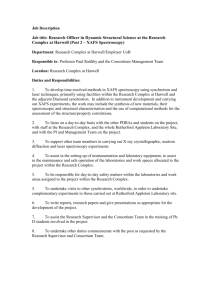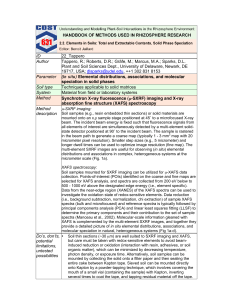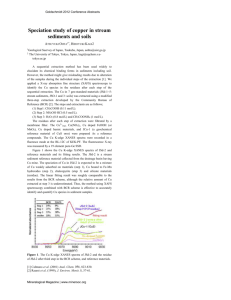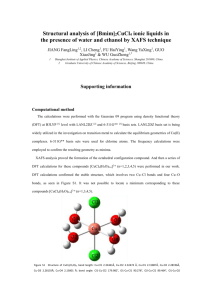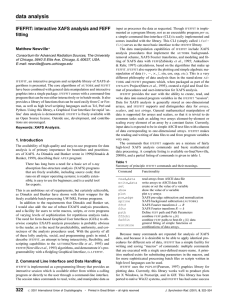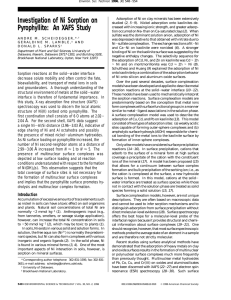631
advertisement
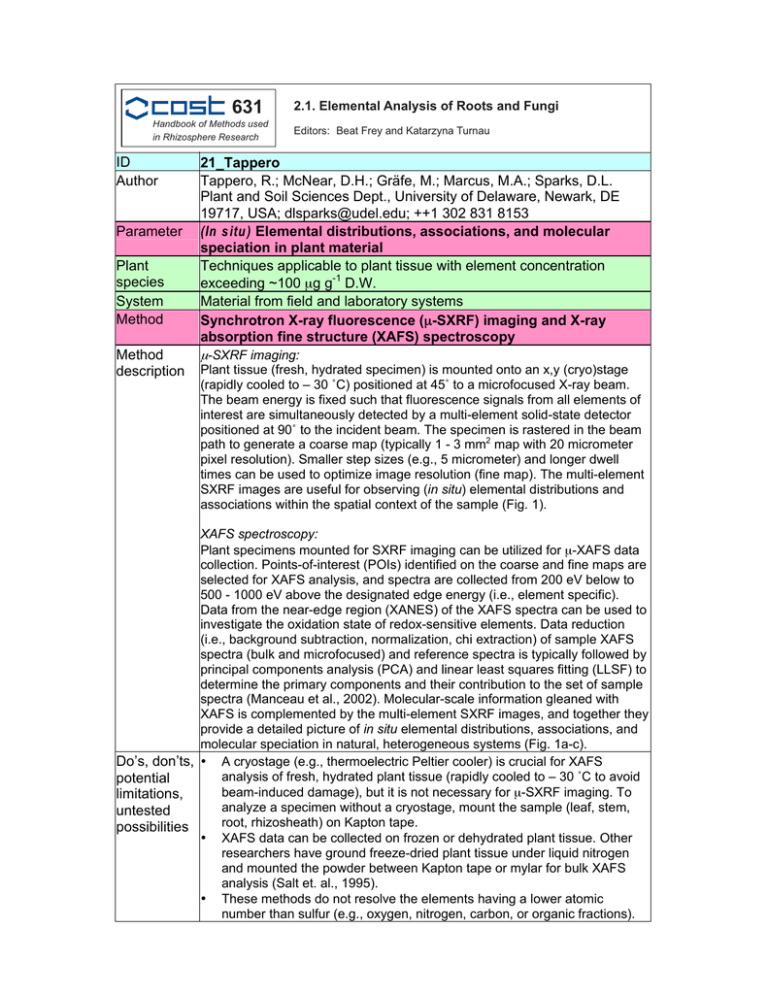
631 Handbook of Methods used in Rhizosphere Research ID Author Parameter Plant species System Method Method description 2.1. Elemental Analysis of Roots and Fungi Editors: Beat Frey and Katarzyna Turnau Tappero, R.; McNear, D.H.; Gräfe, M.; Marcus, M.A.; Sparks, D.L. Plant and Soil Sciences Dept., University of Delaware, Newark, DE 19717, USA; dlsparks@udel.edu; ++1 302 831 8153 (In situ) Techniques applicable to plant tissue with element concentration exceeding ~100 µg g-1 D.W. Material from field and laboratory systems µ µ-SXRF imaging: Plant tissue (fresh, hydrated specimen) is mounted onto an x,y (cryo)stage (rapidly cooled to – 30 ˚C) positioned at 45˚ to a microfocused X-ray beam. The beam energy is fixed such that fluorescence signals from all elements of interest are simultaneously detected by a multi-element solid-state detector positioned at 90˚ to the incident beam. The specimen is rastered in the beam path to generate a coarse map (typically 1 - 3 mm2 map with 20 micrometer pixel resolution). Smaller step sizes (e.g., 5 micrometer) and longer dwell times can be used to optimize image resolution (fine map). The multi-element SXRF images are useful for observing (in situ) elemental distributions and associations within the spatial context of the sample (Fig. 1). XAFS spectroscopy: Plant specimens mounted for SXRF imaging can be utilized for µ-XAFS data collection. Points-of-interest (POIs) identified on the coarse and fine maps are selected for XAFS analysis, and spectra are collected from 200 eV below to 500 - 1000 eV above the designated edge energy (i.e., element specific). Data from the near-edge region (XANES) of the XAFS spectra can be used to investigate the oxidation state of redox-sensitive elements. Data reduction (i.e., background subtraction, normalization, chi extraction) of sample XAFS spectra (bulk and microfocused) and reference spectra is typically followed by principal components analysis (PCA) and linear least squares fitting (LLSF) to determine the primary components and their contribution to the set of sample spectra (Manceau et al., 2002). Molecular-scale information gleaned with XAFS is complemented by the multi-element SXRF images, and together they provide a detailed picture of in situ elemental distributions, associations, and molecular speciation in natural, heterogeneous systems (Fig. 1a-c). Do’s, don’ts, • A cryostage (e.g., thermoelectric Peltier cooler) is crucial for XAFS analysis of fresh, hydrated plant tissue (rapidly cooled to – 30 ˚C to avoid potential beam-induced damage), but it is not necessary for µ-SXRF imaging. To limitations, analyze a specimen without a cryostage, mount the sample (leaf, stem, untested root, rhizosheath) on Kapton tape. possibilities • XAFS data can be collected on frozen or dehydrated plant tissue. Other researchers have ground freeze-dried plant tissue under liquid nitrogen and mounted the powder between Kapton tape or mylar for bulk XAFS analysis (Salt et. al., 1995). • These methods do not resolve the elements having a lower atomic number than sulfur (e.g., oxygen, nitrogen, carbon, or organic fractions). Detection limits are beamline specific and dependent on the composition of the major constituents in the sample (range ~ 20 - 200 µg g-1 ). • Predictions for future developments to this technology include improved spatial resolution (cellular level), detection of lighter (lower Z) elements, and lower detection limits. Run time for most beamlines is limited and access is proposal driven and competitive. References Manceau A.; Marcus, M.A.; Tamura, N. 2002. Quantitative speciation of heavy metals in soils and sediments by synchrotron X-ray techniques. In: Fenter, P.; Sturchio, N.C. (Eds.). Applications of Synchrotron Radiation in LowTemperature Geochemistry and Environmental Science. Reviews in Mineralogy and Geochemistry, Mineralogical Society of America, Washington, DC, Vol. 49: 341-428. • Salt, D.E.; Prince, R.C.; Pickering, I.J.; Raskin, I. 1995. Mechanisms of cadmium mobility and accumulation in Indian Mustard. Plant Physiol. 109: 1427-1433. Salt, D.E.; Prince, R.C.; Baker, A.J.M.; Raskin, I.; Pickering, I. 1999. Zinc ligands in the metal hyperaccumulator Thlaspi caerulescens as determined using X-ray absorption spectroscopy. Environ. Sci. and Technol. 33: 713-717. Links Additional information Scheckel, K.; Lombi, E.; Rock, S.; McLaughlin, M. 2004. In Vivo synchrotron study of Thallium speciation and compartmentation in Iberis intermedia. Environ. Sci. Technol. 38: 5095-5100. http://xraysweb.lbl.gov/uxas/Index.htm Complementary method for soil analysis by SXRF and XAFS (see provides more detail on results of data analysis Fig. 1. µ-SXRF images (Co, Ni) of a fresh, hydrated leaf from hyperaccumulator Alyssum murale (a), Co-XAFS k3-weighted chi (inset) and corresponding Fourier transforms (b) for the leaf tip and mid-leaf region, and line spectra (Co, Ni, Ca) for the region indicated (arrow) on the tricolor SXRF image (c).
